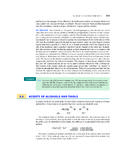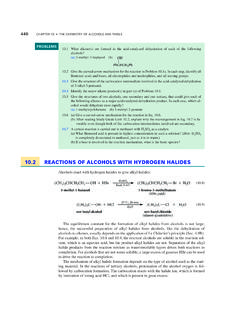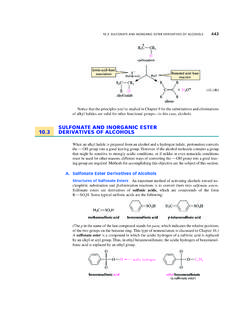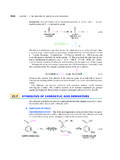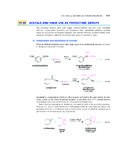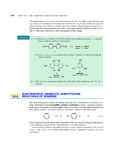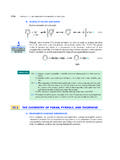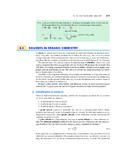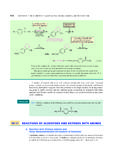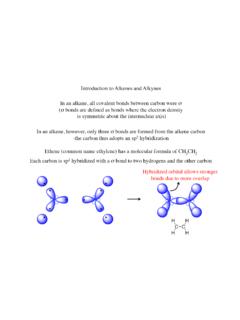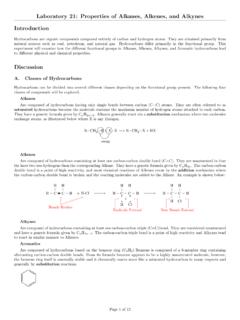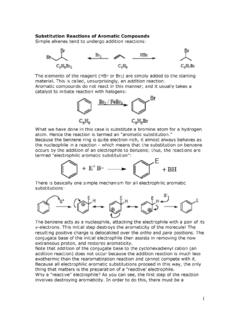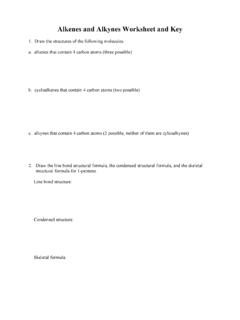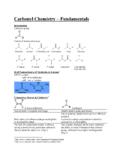Transcription of 5.2 REACTIONS OF ALKENES WITH HALOGENS
1 REACTIONS OF ALKENES WITH HALOGENS181 This is an electron-pair displacement reaction. As this example illustrates, the electrophile inthis type of reaction both accepts and releaseselectrons, but the leaving group only acceptselectrons. Therefore, electronegativity is more important for the leaving group. Although themechanisms of the other addition REACTIONS differ somewhat, we ll find that the same issues of the similarity of these addition REACTIONS and others like them, they are groupedas a class and referred to as electrophilic additions. An addition reaction is an electrophilicaddition when it begins with the donation of an electron pair from a pbond to an (a) Iodine azide, ILN3, adds to isobutylene in the following manner:Which group is the electrophilic group to which the pbond donates electrons?
2 How do youknow? Does this result fit the electronegativity pattern for electrophilic additions? Explain.(b)Predict the product of the following electrophilic addition reaction, and explain your OF ALKENES WITH HALOGENSA. Addition of Chlorine and BromineHalogens undergo addition to products of these REACTIONS are vicinal (Latin vicinus,for neighbor-hood ) means on adjacent sites. Thus, vicinal dihalides are compounds with HALOGENS on ad-jacent and chlorine are the two HALOGENS used most frequently in halogen addition. Flu-orine is so reactive that it not only adds to the double bond but also rapidly replaces all the hy-drogens with fluorines, often with considerable violence. Iodine adds to ALKENES at low tem-perature, but most diiodides are unstable and decompose to the corresponding ALKENES and I2( )CCl4 (solvent)yM%HH+Cl2`LHHClClcyclohexene1,2 -dichlorocyclohexane(70% yield)LLL( )CH3 CHACHCH3Br2+CH3CH"LCHCH3Br2,3-dibromobut anecis- or trans-2-buteneCH2Cl2 (solvent)"Br(CH3)2 CCH2+ (CH3)2 CCH2(CH3)2 CCH2+ 12/5/08 2:47 PM Page 181182 CHAPTER 5 ADDITION REACTIONS OF ALKENESat room temperature.
3 Because bromine is a liquid that is more easily handled than chlorinegas, many halogen additions are carried out with bromine. Inert solvents such as methylenechloride (CH2Cl2) or carbon tetrachloride (CCl4) are typically used for halogen additions be-cause these solvents dissolve both HALOGENS and ALKENES . The addition of bromine to mostalkenes is so fast that when bromine is added dropwise to a solution of the alkene the redbromine color disappears almost immediately. In fact, this discharge of color is a useful qual-itative test for addition can occur by a variety of mechanisms, depending on the solvent, thealkene, and the reaction conditions. One of the most common mechanisms involves a reactiveintermediate called a bromonium bromonium ionis a species that contains a bromine bonded to two carbon atoms; thebromine has an octet of electrons and a positive charge.
4 Formation of the bromonium ion oc-curs in a single mechanistic step. However, it is easier to understand how it is formed if we dis-sect bromonium-ion formation into two fictitioussteps. In the first step, the electrons of the pbond are donated to one of the bromines, the other bromine acts as a leaving group, and a car-bocation is formed. This is exactly like carbocation formation in the reaction of HBr with analkene, except that in this case, Br rather than H is the electrophile. In the second step, the car-bocation undergoes a Lewis acid base association reaction with the neighboring bromine. Step 2 is an intramolecular (internal) Lewis acid base association reaction. The intramolecu-lar reaction occurs in preference to the intermolecularreaction with bromide ion because thefirst bromine is next door and, unlike the bromide ion, doesn t have to rely on random dif-fusion to find the ions are favored energetically over carbocations because every atom in abromonium ion has a full octet of electrons.
5 Although bromonium ions, like carbocations, arereactive intermediates, bromonium ions have been isolated under special conditions. Analo-gous halonium ions form when chlorine or iodine reacts with mechanism in Eq. , through conceptually useful, is fictitious because carboca-tions are not actual intermediates in most halogen additions. We know this because alkenesthat give carbocation rearrangements in HBr addition do not give rearranged products inbromine addition. Other evidence involves stereochemical arguments, which we ll considerin Chapter 7. Hence, we revise our fictitious mechanism in Eq. to show the formation ofthe bromonium ion in a single step. To do this, we merge the curved arrows of the two stepsinto a single step. ( )step 1step 23Br3|)))3Br312_3Br312_3Br313Br32|)3Br32 CH3 CHACHCH3CH3 CHLCHCH3CH3 CHLCHCH3nucleophilenucleophileelectrophi leelectrophileleaving group( )+Br23Br3|3Br312_a bromonium ion)) 12/5/08 2:47 PM Page REACTIONS OF ALKENES WITH HALOGENS183 Bromine addition is completed when the bromide ion donates an electron pair to either oneof the ring carbons of the bromonium ion.
6 This is another electron-pair displacement reaction (Sec. ), in which the nucleophile is bro-mide ion, the electrophile is the carbon that accepts an electron pair from the nucleophile, andthe leaving group is the bromine of the bromonium ion. (The leaving group doesn t actuallyleave the molecule, because it is tethered by another bond.) This reaction occurs because thepositively charged bromine is very electronegative and readily accepts an electron pair. It alsooccurs because, as we ll learn in Chapter 7, three-membered rings are strained, as you can seeif you attempt to build a model; opening a three-membered ring releases considerable HalohydrinsIn the addition of bromine, the only nucleophile (Lewis base) available to react with thebromonium ion is the bromide ion (Eq.)
7 When other nucleophiles are present, they, too,can react with the bromonium ion to form products other than dibromides. A common situa-tion of this type occurs when the solvent itself is a Lewis base. For example, when an alkeneis treated with bromine in a solvent containing a large excess of water, a water molecule ratherthan bromide ion reacts with the bromonium of a proton from the oxygen in a Br nsted acid base reaction gives the product.( )HO32""3Br3+1a bromohydrinH3OO3""LHH|23Br3"2|H2O31CH3 CHLCHCH3CH3 CHLCHCH3( )H2O312"O3""LHH|Br3|33Br3))CH3 CHLCHCH3CH3 CHLCHCH3( )3Br312_3Br313Br323Br3|""))CH3 CHLCHCH3CH3 CHLCHCH3nucleophileleaving groupelectrophile( )"3Br3_123Br313Br32CH3 CHACHCH33Br3|))CH3 CHLCHCH3(2) The other bromineserves as a leaving group.(3) The bromine donatesan electron pair to form theother C Br bond.
8 (1) The p bond of the alkenedonates an electron pair to one bromine to form one C Br 12/5/08 2:47 PM Page 183184 CHAPTER 5 ADDITION REACTIONS OF ALKENESThe product is an example of a bromohydrin:a compound containing both an LOH and aLBr group. Bromohydrins are members of the general class of compounds called halohy-drins,which are compounds containing both a halogen and an LOH group. In the most com-mon type of halohydrin, the two groups occupy adjacent, or vicinal, formation involves the net addition to the double bond of the elements of a hypo-halous acid, such as hypobromous acid, HOLBr, or hypochlorous acid, HOLCl. Althoughthe products of I2addition are unstable (see Sec. ), iodohydrins can also be the double bond of the alkene is positioned unsymmetrically, the reaction of waterwith the bromonium ion can give two possible products, each resulting from breakage of a dif-ferent carbon bromine bond.
9 The reaction is highly regioselective, however, when one carbonof the alkene contains twoalkyl substituents.( )The reason for this regioselectivity can be seen from the structure of the bromonium ion(Fig. ). In this structure, about 90% of the positive charge resides on the tertiary carbon, andH2O+HBr+CAH3CH3 CCH2Br2+$)(solvent)(77% yield)H3 CLCCH3OH""CH2Br"CL""CLXL""OHgeneral structureof a vicinal halohydrin(R = alkyl, aryl, or H)X = Cl, a chlorohydrin Br, a bromohydrin I, an iodohydrinRRRR longer bondpositively chargedcarbon(a)(b)eyeball view of EPMBrFigure (a) A ball-and-stick model showing the structure of the bromonium ion involved in bromine additionto 2-methylpropene. Notice the very long bond between the bromine and the tertiary carbon. (b) An EPM of thebromonium ion viewed from the direction of the eyeball in part (a).
10 Notice the concentration of positive charge onthe tertiary carbon, which is indicated by the blue color. About 90% of the positive charge resides on this 12/5/08 2:47 PM Page REACTIONS OF ALKENES WITH HALOGENS185the bond between this carbon and the bromine is so long and weak that this species is essen-tially a carbocation containing a weak carbon bromine t e r r e a c t s w i t h t h e b r o m o n i u m i o n a t t h e t e r t i a r y c a r b o n , a n d t h e w e a ke r b o n d t o t h e l e av -ing group is broken, to give the observed regioselectivity.( )Study Problem of the following chlorohydrins could be formed by addition of Cl2in water to an alkene? mechanistic reasoning used in this section shows that the nucleophile(water) reacts with the carbon of the double bond that has more alkyl substituents.
